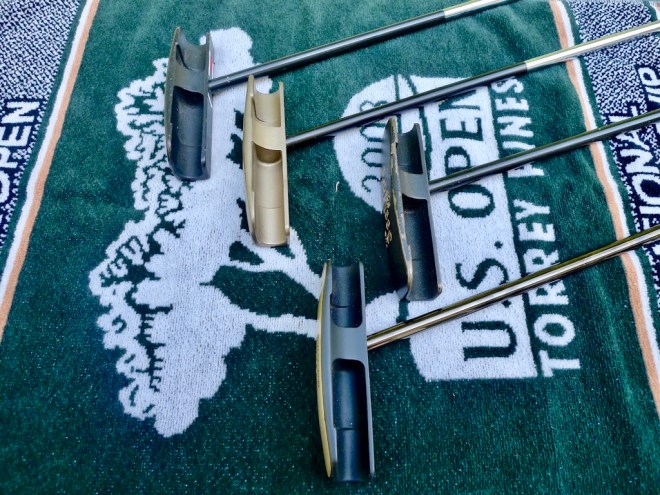Here is the final part of my 2014 golf short story, Kingdom of Dreams.
Thanks for listening. I hope you’ve enjoyed it.

Here is the final part of my 2014 golf short story, Kingdom of Dreams.
Thanks for listening. I hope you’ve enjoyed it.

I bought my first SeeMore FGP on a whim. The aged FGP was sitting forlorn deep in the used putter orphanage at my local golf shop.
I believe I paid $35 for my belovedFGP.
That FGP marked a significant development for my putting. Before I owned that putter, I had played many different styles of putters, never staying with any one design for long and always being disappointed with my putting.
Then came the FGP. That original SeeMore FGP forever changed my outlook on putting. Putts started to look makable and on good days, easy.

Yup, as of today I own four SeeMore FGPs. The original, the one my golf buddy has named, Big Daddy, stays home during most rounds. It will always be my favorite but I usually find myself using my only new FGP, a limited edition putter (mine is number 45 of 100), when I play. I like the all-black shaft a little better than the two-tone shafts of the originals.
All of my FGPs use brass heads. I have used a stainless version of the FGP before but something about the sound is slightly less satisfying to me. It took me forever to find an all-brass model then one day a fine example popped up with its original cover and a somewhat smooth SeeMore grip.

The SeeMore grip is great for originality’s sake but I prefer the superb Rosemark grip. The IOmic grip in the photo is a temporary stand-in while I wait for another Rosemark.

Used SeeMore head covers are hard to come by in good shape. I wish SeeMore would make a move to covers from AM&E but that’s only because I’m a relentlessly picky SOB. In addition to the old and new original SeeMore covers there’s my new UCLA cover and a simple but high quality leather cover from Stitch Golf.

My latest FGP acquisition is another adopted orphan. Its finish was rough but the face and top line were clean so I snapped it up for $30. I am waffling between the idea of refinishing the crinkle-black finish or leaving it rat-rod style. I did take one liberty with the putter. It was originally built to 36″ so I carefully cut it down to 34″ to match its stablemates and installed the IOmic for now.
In my opinion, the design of the SeeMore FGP is as relevant to putting as the Ping Anser and, arguably, the FGP is the better design from the standpoints of ease of use and pure performance. For players who are wise enough to adopt the design and learn to use SeeMore’s simple, logical system better putting is all but assured. You won’t have to buy four SeeMore putters to learn the lesson. Buy one and you’ll be sold forever.

You can buy this little beauty here.
I’m grateful to Fred Greene, head honcho of the GolfSmarter podcast, for a number of things. One that I hadn’t anticipated was how much I enjoyed being interviewed by him for his podcast. Though it was a little out of my experiential-comfort zone, I really enjoyed it. I’m a born talker (as I think most writers are) but speaking formally over the course of 30 minutes is a different kind of talking than most of us are used to doing.
But, again, I liked it. I soon had the idea of doing an audio version of my golf short story, Kingdom of Dreams. I saw the effort as a study that would help me determine whether I could successfully narrate my novel, John J. McDermott & the 1971 U.S. Open.
I think I can.
Though I’m not bowled over by the quality of my narration so far the results seem workable and I’m hoping to get better as I gain experience and learn from my inevitable mistakes.
It didn’t take long to figure out I needed a microphone that was better than the built-in mics in any of my Macs or my iPhone. I asked around and did (very) little research.
A trusted podcaster I know recommended the Blue Yeti but I wasn’t all that enthusiastic about dropping $125 on something that could soon end up collecting dust on a shelf.
So, I decided on the Fifine K669B. I’m mean, it’s only $29 at Amazon and it’s Prime-eligible so there’s very little to lose.
Some of you may know I worked in high end audio for decades and have reviewed well over a hundred high end products. I’ve also been formally and informally involved of scores of recording sessions from pop to classical.
But, I’ve never actually reviewed a microphone. The more I thought about it the more I realized that something really critical to proper audio reviewing was missing.
There’s no reference.
Nearly all of the web and youtube reviews of mics compare one mic to another. I understand this temptation but the better or worse game that’s pretty much useless in evaluating playback gear is even more useless in evaluating source gear.
Why?
Let’s say it again…there’s no reference.
A given reviewer may like the way his voice sounds on Mic A instead of Mic B but that is no predictor of whether anyone else will like the sound of their voice when captured by Mic A.
A significant part of mic performance can be evaluated objectively but most reviewers confine their objective comments to describing features which is fine as far as that goes, but features do not relate directly to quality when you’re talking about audio fidelity.
So, what can I say about the Fifine? I can say it’s fine…for me. It has a fixed cardioid pattern that’s well suited to my simple needs and is truly plug & play (at least on a Mac).
Also, the little fellow is nicely put together, seemingly solid, yet not overly heavy. Some will surely complain about the captive USB cable but at least you know that if you remembered to bring the mic you also remembered the cable!
The only adjustment on the mic is for volume and I found the sensitivity to be plenty wide for my needs and is quite smooth. The volume knob has a reassuringly heavy feel and is easy to position precisely and consistently.
I found set up to be as simple as plugging the mic in and hitting record and I designate the sound quality as just dandy (I know; far too many technical terms).
For $29 there’s just nothing for me to complain about.
Lastly, the Fifine Folks appear to be very responsive at least related to their Amazon sales. This is especially impressive for such an inexpensive product and shows the company understands that early efforts related to customer service will help them build their brand over time.
Well done, Fifine. You’ve done a fantastic job with K669B.
Here is Part 4 of Kingdom of Dreams:
You can buy the ebook here: Kingdom of Dreams for Kindle.
Thanks for listening and please drop by again soon to hear Part 5.

This is Part 3 of Kingdom of Dreams, my 2014 golf short story.
Part 4 will be available soon so please check back.
I hope you enjoy it and thanks for having a listen.
By the way, you can buy the ebook here: Kingdom of Dreams ebook at Amazon.
After a lengthy delay, the print-version of my novel, John J. McDermott & the 1971 U.S. Open, is available at Amazon.
You can get your very own copy of the paperback here.
The delay was related to the cover. I’m usually not one to point fingers but I was the problem.
There, I said it…now go buy a copy.
This is Part 2 of Kingdom of Dreams, my 2014 golf short story.
Part 3 will be available soon so please check back.
I hope you enjoy it and thanks for stopping by and having a listen.
You can buy the ebook here: Kingdom of Dreams ebook at Amazon.